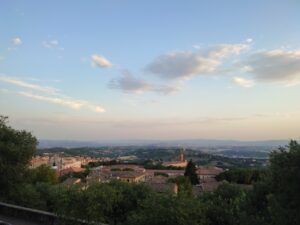Located in County Wicklow, Ireland, Glendalough is a place of significant historic and cultural value. It is renowned for its stunning natural beauty, rich history, and ancient monastic settlement.
Glendalough, which means “Valley of the Two Lakes” in Irish, is situated in a glacial valley and is surrounded by picturesque mountains and forests. The area’s breathtaking landscapes have attracted visitors for centuries.
The most notable feature of Glendalough is its monastic site, which was founded by St. Kevin in the 6th century. St. Kevin was an early Christian hermit and scholar who established a monastery in this secluded valley. The monastic settlement grew and flourished over the centuries, becoming an important center of learning, art, and spirituality.The monastic site of Glendalough includes several fascinating structures, such as the iconic Round Tower. These towers, built during the early medieval period, served as bell towers, places of refuge, and symbols of monastic power. The Glendalough Round Tower stands approximately 30 meters tall and is remarkably well-preserved.Other notable features of the monastic site include several churches, crosses, and a large cemetery. The ruins of St. Kevin’s Church and St. Mary’s Church provide glimpses into the religious and architectural practices of the time.
Glendalough’s historical significance extends beyond its monastic heritage. The valley witnessed various events and changes throughout Irish history. It served as a site of refuge during times of political unrest, and its strategic location made it a target for raids and invasions.
Today, Glendalough is part of the Wicklow Mountains National Park and attracts numerous tourists and nature enthusiasts. Visitors can explore the ancient monastic ruins, hike along scenic trails, and enjoy the tranquility of the lakes and surrounding wilderness.
Pilgrimage Destination: Glendalough became an important pilgrimage site during the Middle Ages. People would journey to the valley to seek spiritual solace, pay homage to St. Kevin, and participate in religious ceremonies. The pilgrimage tradition continues to this day, with some visitors walking the ancient Wicklow Way pilgrimage route that leads to Glendalough.
Cultural and Educational Center: The monastic settlement of Glendalough was not only a place of religious significance but also a hub of learning and education. Monks in Glendalough were known for their scholarly pursuits, copying manuscripts, and preserving important texts. The settlement attracted scholars from far and wide, contributing to the dissemination of knowledge and the arts.
Viking Invasions: Glendalough was not immune to the Viking invasions that affected Ireland during the early medieval period. The Vikings targeted monastic sites like Glendalough for their wealth and treasures. Despite facing raids and destruction, the monastic community managed to rebuild and thrive.
Role in Irish History: Glendalough and the surrounding region played a role in various historical events. During the Irish Rebellion of 1798, the area saw significant activity, as rebel forces sought refuge in the mountains. The remains of a military road built during that time can still be seen near Glendalough.
Natural Features: Glendalough’s historic value is intertwined with its natural surroundings. The two lakes, Upper and Lower Lake, add to the scenic beauty and create a serene atmosphere. The combination of rugged mountains, lush greenery, and cascading waterfalls enhances the overall allure of the valley.
Cultural Significance: Glendalough has been celebrated in Irish literature, folklore, and art. Its ethereal landscapes and historic ruins have inspired poets, writers, and painters for centuries. The valley’s mystical charm and connection to Ireland’s past continue to captivate the imagination of artists and visitors alike.
Conservation and Preservation: Recognizing the significance of Glendalough, efforts have been made to preserve and protect the site. The establishment of the Wicklow Mountains National Park in 1991 ensures the safeguarding of the natural and cultural heritage of the area, allowing future generations to experience its historic value.
Glendalough stands as a testament to Ireland’s early Christian history, its resilience in the face of invasions, and the enduring beauty of its landscapes. Exploring the valley provides a captivating journey through time and nature, making it a must-visit destination for history enthusiasts, nature lovers, and anyone seeking a deeper understanding of Ireland’s past.
In summary, Glendalough holds immense historic value as an ancient monastic settlement founded by St. Kevin. Its well-preserved ruins, including the iconic Round Tower, offer insights into Ireland’s early Christian heritage. Coupled with its natural beauty, Glendalough remains a popular destination that beautifully combines history and breathtaking landscapes.




